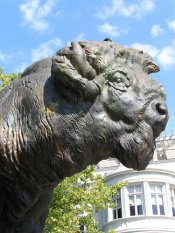|
Date: February 21, 2009 From: We Love DC Monumental: Dumbarton Bridge |
|
 Tatonka!
Tatonka! Tatonka! Tatonka! This week’s Monumental goes by
the aliases of the Buffalo Bridge and the Q Street Bridge, however the
correct DC nomenclature is the Dumbarton
Bridge. Constructed between 1914 and 1915, the bridge spans
high above Rock Creek Park and connects Georgetown to Dupont Circle.
However, bridging these two DC neighborhoods turned out to be easier
said than done. Tatonka!
Tatonka! Tatonka! Tatonka! This week’s Monumental goes by
the aliases of the Buffalo Bridge and the Q Street Bridge, however the
correct DC nomenclature is the Dumbarton
Bridge. Constructed between 1914 and 1915, the bridge spans
high above Rock Creek Park and connects Georgetown to Dupont Circle.
However, bridging these two DC neighborhoods turned out to be easier
said than done.
First, city planners and architects determined that the proximity and location of Dumbarton House posed a traffic congestion problem. Their solution, move the entire house 100ft, no small endeavor, to its current resting spot. And so, the Dumbarton Bridge got its name. The location of Dumbarton House was not the only construction problem facing the bridge. The proposed sections of Q Street, on either side of the bridge, were misaligned. The solution, much simpler than the previous, was to give the bridge one of its most interesting features, a curved roadway. The most striking features of the Dumbarton bridge are its four bullish bison sentries; poised and ready to charge bridge traffic and buck them over the railings. Designed by American sculptor Alexander Phimister Proctor, whose other Washington, DC mammalian works include the Buffalo Heads on Arlington Memorial Bridge and the Panthers on the Piney Branch/16th Street Bridge, these bison are the neighborhood gate watchmen, so watch out cause they don’t take sh#t. Pretty much, they’re the bridge’s secret service, minus the sun glasses. About three years ago, the bison were green, totally patinized and gorgeous. Then one day workmen restored the statues to their metallic, bronze coloring via some form of either protective coating or, gasp!, paint. Why it was suddenly decided to give these statues a new/old “look” is a mystery. Was there some neighborhood debate over restoring the bisons? Did those for and against restoration battled it out, while the bison grew more and more green? Or did the bison’s restoration ticket come up in the backlog of DC’s to do items? For me, the color restoration hasn’t dimished or increased the charisma and physical prescence of these omnispecent creatures. But perhaps the alterations, on some unconscious level, signify society’s collective attempts to remember and glorify the history, animals and people of the American frontier? To enstill them as symbols of our nation’s vitality, strength and integrity, and to not let them corrode and decay in the the annals of U.S. history and, more importantly, the hearts of the American people. |
|
